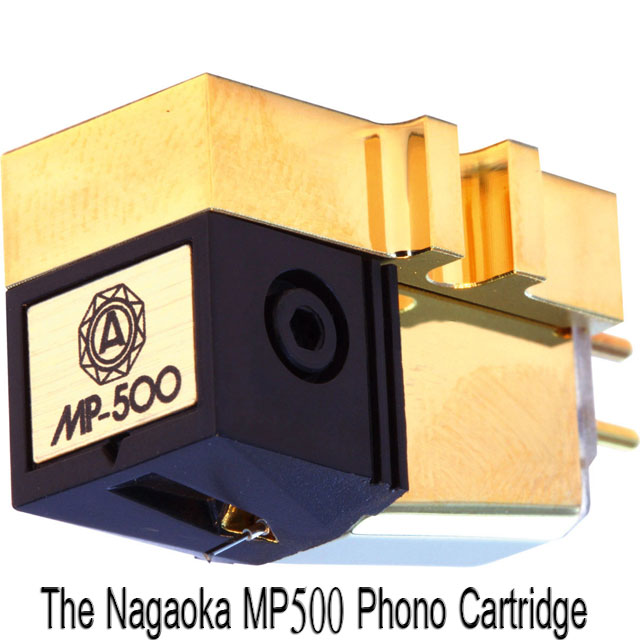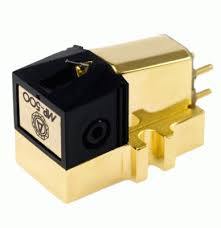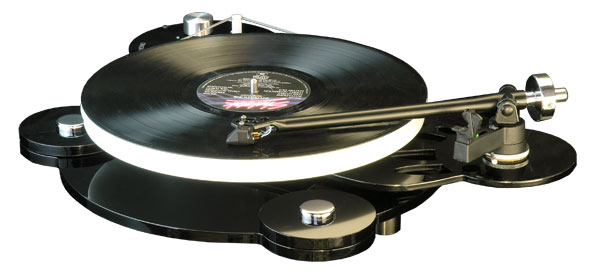Nagaoka MP500 Phono Cartridge

The Nagaoka MP500 stands at the top of Nagaoka’s phono cartridge line. Incorporating a line-contact stylus mounted on a boron cantilever, it is designed for connection to a MM phono stage, and costs $699.00
Whether that price raises howls of unaffordability, or the up-turned lip sneer of the over discretionary-spending endowed, the MP500 is a prime candidate for those looking for an uncompromised cartridge that they can live with for a very long time.
Ever since my entry into the audio world as a hi-fi salesman in 1972, I’ve always been on the look-out for those products which touch the threshold of diminishing returns – products which do all of the requirements of musical and audio performance well enough that further improvement, though tangible and significant, might hint of gilding the lily. The MP500 strikes me as just that sort of product.
The Vinyl Renaissance continues, fuelled now by least two generations of listeners who have only been exposed to music through digital media, and complemented by those who are still invested in the format, or just returning to it. Long-term analogue devotees rejoice at this resurgence, but should be frank that LP playback depends on extremely high-quality mechanical performance from both the turntable and the tonearm to fully reveal the format’s considerable virtues. Those virtues include natural-sounding timbre, exceptional low-level detail and articulation of instrumental technique, visceral depiction of rhythm and timing, and a believable re-creation of the recording site’s acoustic ambience. Neophytes to the LP format struggle to articulate what they find appealing about LP’s, often short-handing to “warmth.” But it can be convincingly argued (and easily experienced) that analogue playback offers a more direct experience of the music’s artistic intention. And aesthetic experience is the prime reason for being involved in audio at all. “It ain’t worth a fart, if it don’t do the Art.”
It is obvious than any component’s performance in an audio system depends on the resolution and quality of the component immediately preceding it in the chain. This truth is particularly true for the phono cartridge. Ever mindful of this basic truth I listened to the Nagaoka MP500 in a variety of system contexts, including 4 different turntables/arms, 9 phono stages, and 5 different loudspeakers. I used the Sound Labs Dynastat as my primary speaker reference, as it is hard to top a 6-foot tall line-source electrostatic panel for revealing ultimate sonic potential and performance nuance.

 The MP500 does not have a threaded mounting platform, so set-up was a bit fiddly, though aided by large-ish, though open, mounting ears, and a removable stylus guard. The boron cantilever’s line-contact stylus requires careful attention to arm height adjustment to ensure correct groove contact. I used a just slightly lower arm pivot point compared to the headshell as a reference set-up (“negative” in VTA/SRA-speak). I set tracking force at 1.7 grams. Nagaoka recommends 30 hours break-in time which did not prove onerous, as the MP500 made music right out of the box.
The MP500 does not have a threaded mounting platform, so set-up was a bit fiddly, though aided by large-ish, though open, mounting ears, and a removable stylus guard. The boron cantilever’s line-contact stylus requires careful attention to arm height adjustment to ensure correct groove contact. I used a just slightly lower arm pivot point compared to the headshell as a reference set-up (“negative” in VTA/SRA-speak). I set tracking force at 1.7 grams. Nagaoka recommends 30 hours break-in time which did not prove onerous, as the MP500 made music right out of the box.
The MP500’s moving-magnet output levels and loading are a definite advantage, as there are more high-resolution MM phono stages available at reasonable prices than there are moving-coil pre-pre-amplifers. The line-contact stylus (blissfully user-replaceable) offers a hidden advantage to collectors of used Vinyl, as it’s unlikely that the used record was played with a line-contact stylus. Thus record wear that shows up when played with an elliptical or conical stylus, appears as virgin vinyl to the line-contact stylus’ groove contact.
I first used the Origin Live DC-motored Linn Sondek LP12 with the Origin Live modified Rega RB250 tonearm. I was immediately impressed by the MP500’s full and rich instrumental timbre: the various choirs of the classical orchestra were readily identifiable. Violins didn’t shriek and were easily separated from violas when their ranges overlapped. Woodwinds and brass were equally well-depicted. Ditto for the bass and percussion instruments and overall the cartridge’s frequency balance was revealed as neutral, linear, and extended, with quick and controlled transient response.
Although the Linn has fallen somewhat from its near-divine cult status (there seems to be a vitriolic anti-Linn backlash on various UK-based internet forums,) it remains superb at music-making. The Origin Live DC-motor conversion substantially irons out the classic Linn bass bump and the table’s ability to ‘play tunes in the bass’ is actually improved. The two near-simultaneous sounds of a wooden drumstick hitting a metallic cymbal (a classic Ivor Tiefenbrun (Linn’s founder) listening test for judging turntable quality) were captured vividly and revealed the MP500’s wide bandwidth resolution and high-frequency detail.
The MP500’s music-making abilities complemented the Linn’s. Listening to all kinds of music was both exalting and rhythmically engrossing, the technique and the meaning of what each instrument was playing clear and comprehensible. It’s become almost a truism that the LP12 excels with Rock and Jazz (its depiction of bass guitar/drum interaction and drive is a hallmark) and that the US audiophile’s typical obsession with imaging and sound-staging is given somewhat shorter-shrift. Given that the majority of recordings are actually multi-tracked, pan-potted Mono (including, sadly, some Classical recordings,) Tiefenbrun’s classic comment of “What image?’ when answering criticisms of the LP12 seems less brusque and dismissive. But, still, Classical music recordings (and indeed, well-recorded acoustic music of all types) do require an accurate portrayal of the sound stage to avoid, at least, perceptual disorientation.
The Merrill acrylic sub-chassis and bearing upgrade on the antique AR XA table (used with Origin Live’s modified Rega RB300) improved the stereoscopic illusion significantly, though it gave up some of the lewd and sinuously suggestive bass rhythms the MP500 revealed so well from the Linn/OL RB250. This was mostly true with well recorded Classical performances where insight into the soundstage changed from perceiving individual islands of performance choirs to a continuous spread with depiction of the space between the islands.
I was mightily impressed at this point with the MP500’s combination of timbral believability, rhythmic aplomb, wide-band resolution, and ease of listening. Just how good is this thing ultimately?

Moving to the Origin Live Aurora table with their Silver tonearm was transmogrifying. Resolution went up hallucinogenically, like the difference between a crystal-clear March day compared to the slight haze of, say, ghostly late October. Not only was each instrument’s timbre significantly clearer and more naturally depicted, but also its position on the sonic stage and the physical nature of its sound field. This was no “Sounds emerging from a Black Hole background” digital distortion, but the portrayal of the ambience of the recording site’s venue in which the sound stage was immersed. This increase in low-level detail and subtle dynamic shifts was marked and welcome. But much more important was the increase in communicating what and how the instruments were playing.
When I first switched to the Origin Live Conqueror tonearm I thought that I had found the limits of the MP500’s potential. Turns out that what I re-experienced was the importance of getting VTA/SRA exactly right. This sensitivity was also true with the Silver arm and is characteristic of all line-contact styli. Be off just a wee bit in your set-up of these two high-resolution arms and you’ll know it instantly. The saving grace of these 2 arms, however, is that you’ll also know, unambiguously, when you’ve gotten it right.
There’s no doubt that the line-contact stylus is the state-of-the-art for maximum extraction of high frequency detail. They produce more than a simple increase in the sense of ‘air’ and hi-res percussion detail: the unique harmonic structure of all instruments is rendered more accurately. Hence instruments are easier to identify, and, because transient performance is also improved, easier to position in space. Exploiting the line-contact stylus’ full potential, however, can have a high PITA (pain in the ass) Quotient. I used the RingMat LP Support System’s method of platter shims to optimize the stylus’ fit into the groove. While this wasn’t completely pain-free, it was anodyne compared to changing arm height by arm-base shims or by other means.
Those not willing to delve into ultimate conscientious arm-height set-up might consider Nagaoka’s MP300 phono cartridge. The MP300 matches much of the MP500 technical and performance aspects but uses an elliptical stylus on its boron cantilever, instead of the MP500’s line-contact tip. Arm height set-up is thus less persnickety. It sells for $100 less than the MP500. I listened to the MP 300 first and was deeply impressed by its musical performance. It lacked only that ultimate transparency that the MP500’s line-contact stylus revealed, which, once heard, was hard to give up.
Using a $699 cartridge on a $3500 arm through rare antique tube gear into 6-foot tall electrostatic panels might be too rarefied for the cartridge’s likely user, so I ran the MP500 into a variety of systems, both tube and solid-state, and with a variety of speakers. Obviously, the better the ancillaries the better the MP500 performed, but it did not require ultimate components to reveal its strengths, though purely ‘entry-level’ components were clearly over-matched. Given the US market’s historical and notorious resistance to investing in high-quality turntables, arms, and phono stages, there is great potential that the MP500’s impressive abilities will go unheard by the use of inadequate turntables and arms. This is particularly true for the computer generation which blanches at spending $200 for a complete turntable, but also applies to those nostalgic listeners excited by “vintage” 1970’s Japanese direct-drive turntables.
So high marks indeed for the Nagaoka MP500. Its combination of broad and neutral frequency response, exceptional high-frequency detail, and its way with both wide dynamics and the subtle details of musicianship lead to great music making. A very very easy and very very enthusiastic recommendation.

![]()
paul szabady
Paul’s Associated Components:
Linn Sondek LP12 w/ Origin Live DC motor mod and upgrade power transformer, Acoustic Research XA turntable w/ Merrill acrylic sub-platter and bearing, Origin Live Aurora w/ upgrade transformer turntables.
Origin Live modified Rega RB 250 and RB300, OL Silver and Conqueror tonearns. Ring Mat LP Support System.
Graham Slee Reflex M and Gram Amp 2SE, EAR 834P, Musical Surroundings Phonomena, phono sections of Eico ST84, Meitner PA6i, Hegeman HAPI 2, NAD 1020, and Marantz 1060.
Sound Labs Dynastat, Spendor 2040, Infinity RS7, Celestion F30, and Cambridge Audio Aeromax 2 speakers.
Specifications:
Nagaoka MP-500 Phono Cartridge Specifications
Price: $699.00
– Type: Moving magnet
– Cantilever: High-strength boron
– Stylus type: Superfine line contact diamond
– Output voltage @ 1kHz,5cm/sec: 3mV
– Frequency response: 20Hz-25kHz
– Channel balance @ 1kHz: > 1dB
– Channel separation @ 1kHz: > 27dB
– Recommended loading: 47k ohms
– Dynamic compliance: 8.5 x 10-6 cm/dyne
– Tracking force range: 1.3 – 1.8 g
– Weight: 8 g
– Break-in period: 30 hours
– Stylus replacement: Nagaoka JN-P500
LP Gear
3024 Via Venezia
Henderson, NV 89052 US
Fax: (725) 888-4711
https://www.lpgear.com/SFNT.html
Stereo Times Masthead
Publisher/Founder
Clement Perry
Editor
Dave Thomas
Senior Editors
Frank Alles, Mike Girardi, Russell Lichter, Terry London, Moreno Mitchell, Paul Szabady, Bill Wells, Mike Wright, and Stephen Yan,
Current Contributors
David Abramson, Tim Barrall, Dave Allison, Ron Cook, Lewis Dardick, John Hoffman, Dan Secula, Don Shaulis, Greg Simmons, Eric Teh, Greg Voth, Richard Willie, Ed Van Winkle, Rob Dockery, Richard Doran, and Daveed Turek
Site Management Clement Perry
Ad Designer: Martin Perry






Be the first to comment on: Nagaoka MP500 Phono Cartridge